The United States is NATO's leader. And if the president of United States doesn't want to play that role, NATO just will not be the kind of alliance that it's been.
- James Goldgeier
As NATO turns 75, alliance leaders gathered in Washington, presenting a united front in support of Ukraine’s survival against the threat from Russia. Brookings Visiting Fellow James Goldgeier reviews the NATO summit’s outcomes, how the organization is trying to prepare for the uncertainty of American leadership after November, and the broader challenges—and partners—in NATO’s future.
Transcript
PITA: You’re listening to The Current, part of the Brookings Podcast Network. I’m your host, Adrianna Pita.
Leaders of NATO member states gathered in Washington, D.C. this week to mark the 75th anniversary of the North Atlantic Treaty Organization’s creation. The gathering was one part summit, one part celebration of what outgoing Secretary General Jens Stoltenberg called “the longest-lasting alliance in history,” but seasoned with a dose of apprehension over the ongoing war in Ukraine and domestic political challenges in both the U.S. and Europe.
With us to talk about the summit and NATO’s road ahead is James Goldgeier, a visiting fellow at the Center on the United States and Europe at Brookings, visiting scholar at Stanford University’s Center for International Security and Cooperation, and a professor at the School of International Service at American University. Jim, thanks for talking to us today.
GOLDGEIER: Great to be with you.
PITA: Starting us off, our colleague, Elizabeth Saunders, wrote that NATO’s 75th birthday present is uncertainty. She was writing about how NATO could be affected by elections in the U.S., U.K., and France. Some people talk about these sort of big moments as being crossroads or inflection points or precipices. How would you characterize where the alliance is today?
GOLDGEIER: Well, Professor Saunders is correct that there was a lot of uncertainty and it’s largely due to the U.S. presidential election coming in November, but I would say what NATO sought to do at this summit and I think did pretty well was convey that it is unified in dealing with the major threat in front of it. And that is the threat posed by the Russian Federation and President Vladimir Putin, and that NATO does see how important it is to continue to support Ukraine in the war, its war, to survive against this Russian onslaught.
But there’s no question that hanging over all of this is the question of what’s going to happen in the November election, a sense that was heightened with the recent presidential debate between Joe Biden and Donald Trump, where people who may not have been paying much attention saw that President Biden certainly came across as both physically and mentally frail compared to where he was when he started his presidency. And so, from a NATO perspective, there’s concern that Donald Trump will be elected president because Donald Trump has said all sorts of negative things about NATO and about allies and so that just injects uncertainty because the United States is the leader of this 75-year-old alliance.
PITA: One of the big things that came out of the summit was, of course, long-time Secretary General Jens Stoltenberg, stepping down, and the former prime minister of the Netherlands, Mark Rutte, being tapped to be the next NATO secretary general. What can you tell us about him and what we should expect from his leadership?
GOLDGEIER: Well, it’s important to note first just how extraordinary Secretary General Stoltenberg has been in his role. He has really shown tremendous leadership skills. He was incredibly important during the Trump years because President Trump had had such negative attitudes toward NATO and toward allies. And Secretary General Stoltenberg really was quite adept at engaging with Trump and talking about the ways in which NATO members were increasing their military spending to share more of the burden within the alliance, which was something that Trump had made clear was very important to him. And Stoltenberg was very good at that. And I think what we see with Mark Rutte is somebody who is quite a skilled politician. He, when I was dean at American University School of International Service, we hosted him as the prime minister of the Netherlands and he demonstrated tremendous political skill, very good interacting with the students, showed what a politician he is. And, you know, political skills are key when you’re trying to manage a group of 32 allies and a number of other partners. The one issue that has emerged with those around Donald Trump is that the Netherlands does not meet the 2% goal that NATO has set for members to spend, 2% of their GDP on defense. And so there’s a lot of questioning by people around Donald Trump as to why this person who represents a country that’s not doing as much as others in terms of percent of GDP on defense, why is this person the new secretary general of NATO? So, in that sense, there is a bit of an issue as he gets started in the job.
PITA: Given the former president’s policies and statements about NATO and aid to Ukraine, there have been lots of questions about how to or whether some of those relationships can be “Trump-proofed.” Did you see any of that coming up at the summit? What were some of the takeaways there that might outlast a more negative next U.S. administration?
GOLDGEIER: The issue really is how do you continue to provide enough of a level of support for Ukraine that it doesn’t get conquered by Russia? NATO is trying to enable Ukraine to survive and at least control the territory that it currently controls and hopefully be able to take back more of the territory that Russia occupies, although that is extremely difficult. So what NATO has done is to try to shift some of the effort that’s been U.S.-led on the military assistance to a new NATO structure that will make NATO as a whole more responsible for the military assistance going to Ukraine. There’s going to be a NATO representative, civilian representative in Kiev who will help to create a more of a relationship even than there is today between Ukraine and NATO. And so there’s this effort, there was also a commitment to $40 billion in military assistance next year, disappointing to many who had hoped for a longer-term statement of commitment of military assistance to Ukraine. So that was something that was disappointing.
But at the end of the day, there really isn’t anything NATO can do to Trump-proof itself. And we just don’t know what Donald Trump’s policies would be toward NATO, but if he were to decide that he wasn’t interested, that he didn’t want to participate in NATO, even if he doesn’t formally withdraw the United States, if he lowers U.S. activities within NATO, if he declares that he’s not committed to Article 5, which is fundamental to NATO, that is that an attack on one member will be considered an attack on all, and that core collective security provision, if Donald Trump takes that approach, that just really weakens NATO in fundamental ways. The United States is NATO’s leader. And if the president of United States doesn’t want to play that role, NATO just will not be the kind of alliance that it’s been. And there’s nothing anyone can do to Trump-proof it, neither from the NATO side or from the U.S. Congress.
PITA: So following up on that, about Ukraine just a little bit more, there was the statement that came out of the summit that NATO will “support Ukraine on its irreversible path to full Euro-Atlantic integration, including NATO membership.” What’s sort of what’s your takeaway there? Does that is that a specific roadmap? Is that just a general supportive statement? What do you take away from that?
GOLDGEIER: It’s a general supportive statement. It’s not much more. You know, what NATO likes to do in these summits is try to move beyond where they were at the previous summit to try to show progress. So last year, NATO agreed that it could invite Ukraine to join when allies agree and conditions are met. That was the vague language that was used and Ukraine wasn’t very happy about that. And those who support Ukrainian membership in NATO wanted something stronger at this summit. NATO reiterated the “allies agree, conditions are met” language, but there was a lot of discussion in the run-up to the summit about whether they could put the “irreversible” language in there to really say, yes, Ukraine really is on a path to NATO membership and it’s going to happen. We don’t know when, we don’t know how, but it’s gonna happen. The United States, President Biden has not been supportive of putting Ukraine on a faster track to NATO membership. So there was some question as to whether he would agree to the “irreversible” language. And from what we understand from news reports, he agreed to it as long as there was also language in there about Ukraine’s need to continue to commit itself to addressing issues particularly related to corruption in Ukraine. But the fundamental problem right now is that there isn’t enough consensus in the alliance for how and when Ukraine would join NATO. So “irreversible” is there. The talk about a bridge to NATO membership is there. But in concrete terms, Ukraine is not any closer to NATO membership than it was.
PITA: On the sidelines of the summit, there was also a panel discussion. This one had the leaders of Estonia, Denmark, and the Czech Republic. And one of the lines of discussion at this panel was about whether European countries, individually, the EU writ large, or NATO, do any of them consider themselves to be at war with Russia? Obviously, not explicitly, and there were nuanced answers to that question. Can I ask you to weigh in on that discussion about how different countries in Europe view Russia? Russia is at war with Ukraine, but how close is that war to themselves?
GOLDGEIER: Well, they do see it as close to themselves. mean, I mean, I think you have a lot of Europeans now who do see the threat from Russia as an existential threat that if Russia succeeds in Ukraine, that this could have real ramifications for other NATO members, that Russia would pose a more direct threat to other NATO members. Certainly that feeling is the strongest in countries that are closest. so you have Estonia, Latvia, Lithuania, the three Baltic countries. These are small, vulnerable countries who always worry about the Russian threat. And so the war, this war has really basically fortified them in their reminding NATO, Russia poses a threat to Europe. There were a lot of NATO members who didn’t really see it that way, even after 2014, and the Baltic countries and Poland have been very strong in trying to remind their NATO allied counterparts, this really is a threat, and that was brought home, has been brought home since February of 2022. NATO’s newest member, Sweden, and also Finland, which joined the previous year, these also see a a huge threat posed by Russia. As you move further west, you there’s less of a direct feeling. But I think in general, Europeans really do understand that Russia poses a distinct threat to Europe, to European security, to the European way of life, so public support across Europe is very strong for continuing to provide assistance to Ukraine.
PITA: Also in attendance at the summit were some non-NATO member countries such as Australia, New Zealand, South Korea. What has NATO’s role been in the Pacific?
GOLDGEIER: So this is something, the heads of state of what are called the Indo-Pacific Four, that’s Japan, South Korea, Australia, New Zealand, they came for the first time to a NATO summit in 2022, in Madrid. They came again last year in Vilnius; they came again this year. And the goal has been to strengthen the dialogue between those countries and NATO with a recognition that these theaters are not completely distinct. That the kind of threat Russia poses in Europe is related to the threat that China poses in the Indo-Pacific. And it doesn’t mean that these countries – they don’t seek NATO membership; NATO is an organization that is trans-Atlantic in its membership. But there’s a recognition by NATO that what’s happening in the Indo-Pacific is important and a recognition by these countries that what’s happening in Europe is important to them. And so, you have this strengthening of these democratic allies across these two regions. It’s extremely important and NATO is trying to develop more dialogue with them and an opportunity to create stronger partnerships. At last year’s summit in Vilnius, there was talk about establishing a NATO liaison office in Japan, but that was opposed by French President Emmanuel Macron, who thought that was too provocative and would exacerbate the situation with respect to China, so NATO did not move forward on that. But NATO also made clear in this summit declaration that Chinese [support] is, quote, a decisive enabler of this war, that Russia could not prosecute this war the way it has without Chinese support. So there’s clearly a view of this linkage and it’s important to NATO that it have the support of these Indo-Pacific four. We’ve seen, for example, South Korea providing some of its stocks of artillery shells to Ukraine to help it in the war. So I think and I hope that these partnerships will deepen.
PITA: Building off of that point, earlier this month you were on a virtual panel with another colleague of ours, Tara Varma. And I’m going to paraphrase her slightly, but she talked about how regardless of the U.S. presidential election, this and future NATO summits will have to answer the question, how does it remain relevant to its core mission, which is the defense of the North Atlantic region, and also remain relevant to the wider set of today’s challenges? And she talked also about how important it is for NATO to demonstrate that it’s prepared itself for the coming decades to the American and to the European publics. You’ve also written about how NATO is on the ballot in the November elections here in the U.S. Did you see the start of any such demonstration that NATO is ready for this broader future, how it’s prepared to do so at the summit? Or what else would you want to see from NATO in making that message explicit to the publics in the U.S. and Europe?
GOLDGEIER: Well, NATO has been trying to do this for some time, because the threats that come to the allies, they’re quite varied. The one that was cited in this summit declaration as a key function for NATO to deal with is counterterrorism because terrorism is seen as a major threat to the members of NATO and so NATO needs to do something about that. For a lot of NATO members, there are of course a broad set of issues, some of which NATO is equipped to deal with and some of which it isn’t. So, for example, for some NATO members, refugees are a serious problem. That’s more of an issue for the European Union to deal with. Climate change affects us all. There’s a role for NATO to play in terms of the carbon footprint that it has as a military alliance, and so it needs to think about what its own contribution to climate change is as a military alliance, but, you know, it’s not an institution that’s really there to deal with those sets of issues. And so I think what we saw in this summit declaration was the clear signal that Russia is the main threat to European security and that NATO is going to support Ukraine to try to address the Russian threat. But even there, it’s not just a military threat. Russia is attacking Ukraine, but it’s also engages in cyber warfare, disinformation, all sorts of ways to disrupt NATO members in ways that NATO is extremely concerned about and has to deal with.
And then, as I said, the other issue that really came up to the top alongside the Russia threat is counterterrorism, NATO’s need to really be able to do counterterrorism effectively, that terrorism is the other main threat to the alliance. But Tara’s right, there is a broad range of threats and for an organization where so much bandwidth right now is taken up by the Russia-Ukraine war, it’s hard to be able to address all these other things as well.
PITA: All right, Jim, thank you very much for talking to us today about this.
GOLDGEIER: Great to be with you. Thanks for having me.
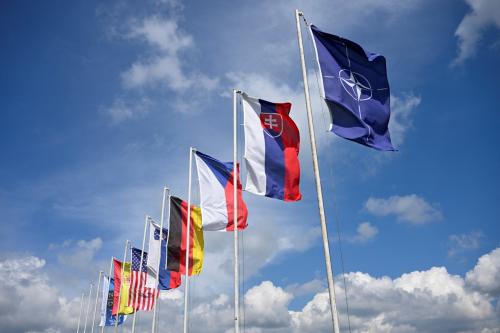
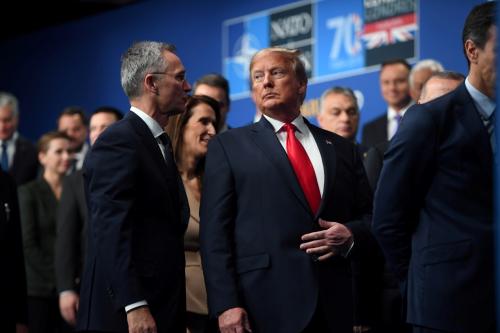
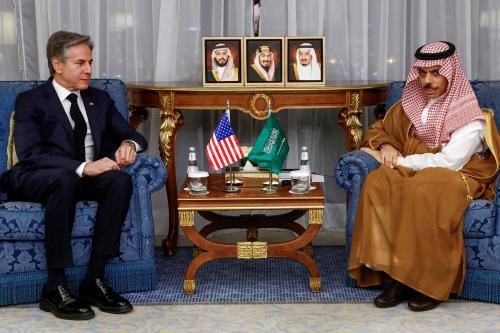
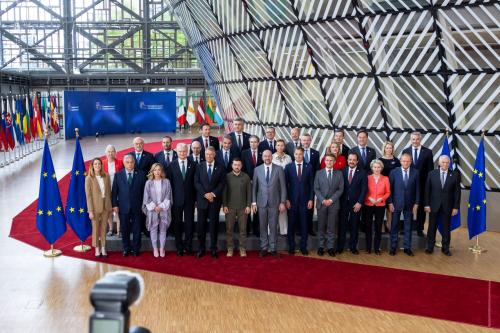
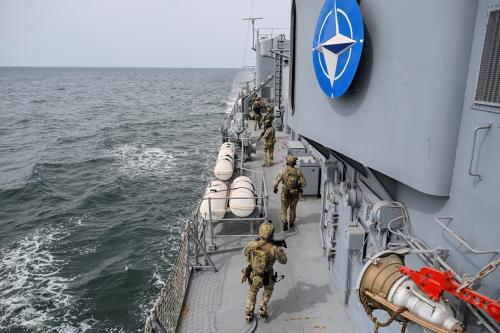
Commentary
PodcastThe state of NATO at 75 and beyond
July 12, 2024